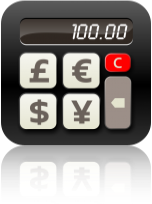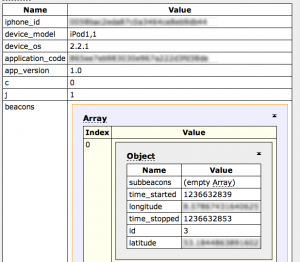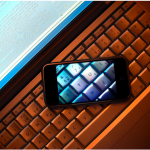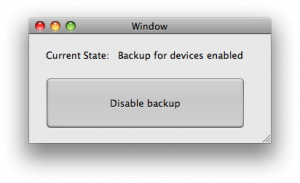
|
[See Demo] [eCurrency on iTunes]
eCurrency is an intuitive, easy-to-user currency converter providing up-to-date exchange rate information. The ideal accompaniment for overseas travel and shopping, as well as business trips abroad. Features:
|

While developing an iPhone App I ran accross Pinch Media. This company is offering free “application usage statistic tools” for iPhone developers. All you have to do is register and integrate a library provided by Pinch Media into your iPhone app and you get live statistics of your application’s usage (sorted by country, time of usage, iphone/ipod type…) on the Pinch Media Website. Sounds pretty good, huh?
I tested Pinch Media’s offerings and found out:
- Every time you quit an application that integrates Pinch Media, the following data gets transferred to Pinch Media: iPhone UUID (the unique ID of your iPhone), Iphone Software release, iPod/iPhone version, a timestamp when application usage started, a timestamp when application usage ended and (if you allowed it) the longitude and lattitude values of your position. You can see the detailed data that gets send out to Pinch Media in the graphic to the left.
- If no active internet connection is detected, the usage data gets saved to an sqlite database for every session. The next time there is an internet connection available all that data gets send out to Pinch Media servers (beacons.pinchmedia.com).
- This all happens in the background. The user has no clue that data is send out to Pinch Media.
I got curious how many applications in the App Store already integrate Pinch Media. I did a quick check on my iPhone (such a check works only on jailbroken-phones, look for the pinchmedia subfolder in Documents of each applications) I have currently 30 3rd party applications installed. 9 of them integrated Pinch Media. Your mileage may vary, but it just shows that a lot of applications seem to use Pinch Meda already. Just to note: None of these apps mention anywhere that they are sending out data to 3rd parties (Pinch Media).
While I can see the huge benefit of Pinch Media for me as an application developer, I decided not to integrate it.
Here is why: I have a problem with applications sending out private data to 3rd parties in the background, while the user has no clue that this is happening. Whatever Pinch Media uses this data for (I guess advertising-their other service), I think its not good practice. While many people are afraid that Google is collecting lots of data, it seems regarding iPhone Applications Usage statistics there is already some other “Big Brother”. The “Pinch Media Analytics Tools” for iPhone Applications are comparable what “Google Analytics” is for Websites. But there is a big difference: You can easily find out, if a website uses Google Analytics by just looking at the HTML source; but thats hard to do with iPhone applications.
While people are critical about what’s going on on their desktop computers (applications phoning home etc.) and can block those activites with firewalls, this awareness seems to be missing when it comes to SmartPhones until now. If you are on a celluar network you have no control to block (e.g. by a firewall) what the application is doing and which servers it is sending data to. You have to trust the application developer, that the application is doing what was announced. As 3rd party applications on smartphones have just started to emerge, this is for sure some problem that has to be solved in the future. Until then developers should explicitly announce somewhere in the application description, if they send out data to 3rd parties and give the user an option to turn this behaviour off.

To find out the LCD model (and manufacturer) of the display in your Macbook or Macbook pro, open a terminal window and paste the following code followed by enter:
ioreg -lw0 | grep IODisplayEDID | sed "/[^<]*</s///" | xxd -p -r | strings -6
This gives you e.g. the following information:
B133EW01 V0
Color LCD
The first line is the LCD model number, the second is the active color profile.
If you google the LCD Model number, you can find out more about your screen (contrast ratio, brightness).
For my screen (build into a 1st generation Macbook build in 8/2006) I get the following information:
Info about B133EW01 Screen Model
The screen quality of the new aluminium Macbook is not very good (compared to the Macbook Air and Macbook Pro) and prevents me from buying a Macbook at the moment. As the Macbook Air is not powerful enough for me and the Macbook Pro is too large (I travel a lot) I send the following E-Mail to Steve Jobs:
Hi Steve,
I am a longtime mac user and developer and considering to the buy the new macbook as a replacement for my old machine.
Seeing the macbook screen in a store next to a MBP and MBA however did not convince me quality wise (bad viewing angle, much more washed out colors than MBP and MBA).
These pictures I found on the net demonstrate the issue quite well:
http://att.macrumors.com/attachment.php?attachmentid=141668&d=1225128519
http://att.macrumors.com/attachment.php?attachmentid=141669&d=1225128519
Some might argue I could just get a MBA or MBP; but I am a heavy traveller. So the MBP is too large for me and the MBA is too limited (I need 4GB RAM). I do understand from a business perspective that the MB has an inferior screen as it's the entry line, but I would suggest to do one of these two options to attract even more people to the MB:
1) Put the better screen (the one the MBA currently has) into the 1499$ model and charge maybe 50$ more for it.
2) Make the better screen a BTO option for both MB models and charge for it.
Considering the buzz on the net about macbook screen quality I think these options would make a lot of people happy, who want a small powerful machine.
Best,
Hendrik
The just released 2.0.2 firmware update seems to improve the 3G reception for iphone 3G owners.
But what does it bring to the iPhone 2G?
Some things I found out so far:
- It seems to be a bit more snappy (lag in typing and adressbook scrolling is less)
- The build-number is 5C1
- The baseband does not seem to be upgraded (still 04.05.04_G). That means everyone who pwned their phone and updates to 2.0.2 will loose the jailbreak, but the phone should stay unlocked and activated.
- Backups still take way too long. If you just backuped your phone before the upgrade, backup seems faster initially but for me backup speed decreased as soon as I removed/installed some applications.
- Installing applications takes still way too long if you have a certain number of applications already installed.
 While you could already disable backups completly using DisableBackup 1.0 (or the some terminal commands) and iTunes 7.7, the updated iTunes 7.7.1 includes more hidden options to configure the behavior of the iTunes Backup proccess. With iTunes 7.7.1 a hidden option was introduced to disable only automatic backups. Using the context menu for your device (as shown in the screenshot) manual backups can still be forced at any time. This is for sure a better option than the “disable backups completly option” available in Tunes 7.7. My small helper app DisableBackup has been updated to use this new 7.7.1 feature. You can download version 2.0 of DisableBackup here.
While you could already disable backups completly using DisableBackup 1.0 (or the some terminal commands) and iTunes 7.7, the updated iTunes 7.7.1 includes more hidden options to configure the behavior of the iTunes Backup proccess. With iTunes 7.7.1 a hidden option was introduced to disable only automatic backups. Using the context menu for your device (as shown in the screenshot) manual backups can still be forced at any time. This is for sure a better option than the “disable backups completly option” available in Tunes 7.7. My small helper app DisableBackup has been updated to use this new 7.7.1 feature. You can download version 2.0 of DisableBackup here.
 Disabling the slow iTunes Backup on Windows is a little more tricky, but it works. First of all close ITunes and then follow these steps:
Disabling the slow iTunes Backup on Windows is a little more tricky, but it works. First of all close ITunes and then follow these steps:
- Locate your iTunesPrefs.xml file. It’s usually located in C:\Documents and Settings\username\Application Data\Apple Computer\iTunes or C:\Documents and Settings\username\Local Settings\Application Data\Apple Computer\iTunes.
Hint: If the folder Application Data does not show up, make sure that hidden files are visible in the Windows Explorer
- Backup your iTunesPrefs.xml file
- Open iTunesPrefs.xml using a capable text-editor (e.g. Notepad++, Ultraedit, but not MS Notepad)
- Search for a section called User Preferences and paste the following snipped into the User Preferences Section after the first <dict>:
<key>DeviceBackupsDisabled</key>
<data>
dHJ1ZQ==
</data>After you've done that it should exactly look like the screenshot on the left.
- Save the file and restart iTunes. Backups should now be disabled. To enable backups again delete the XML Snippet from iTunesPrefs.xml file.
 For those of you not familiar with the terminal I wrote a simple application, that lets you disable and enable backups for the iPhone/ipod touch with a single mouse click.
For those of you not familiar with the terminal I wrote a simple application, that lets you disable and enable backups for the iPhone/ipod touch with a single mouse click.
Requirements: Mac OS X 10.4 or higher
This only works on the mac. Windows Users click here.
 If you have installed a lot of applications on your iPhone, the backup can take forever. Itunes does not back the application data only, but the whole application binary everytime. To disable the slow back up type
If you have installed a lot of applications on your iPhone, the backup can take forever. Itunes does not back the application data only, but the whole application binary everytime. To disable the slow back up type
defaults write com.apple.iTunes DeviceBackupsDisabled -bool true
defaults write com.apple.iTunes DeviceBackupsDisabled -bool false The MobileMe WebInterface does only support modern browsers like Internet-Explorer 7 or higher, Safari 3 or higher and Firefox 2 or higher. If you are still using Internet Explorer 6 (and many have to e.g. at their workplace) you are doomded: There is no way to access your email using an offical web-client from Apple.
The MobileMe WebInterface does only support modern browsers like Internet-Explorer 7 or higher, Safari 3 or higher and Firefox 2 or higher. If you are still using Internet Explorer 6 (and many have to e.g. at their workplace) you are doomded: There is no way to access your email using an offical web-client from Apple.
But there is a solution:
- Open the webpage http://mail2web.com
- Login using your MobileMe-username (e.g. steve@me.com) and using your password.
- You should have access to your mails and you can also compose new emails.

